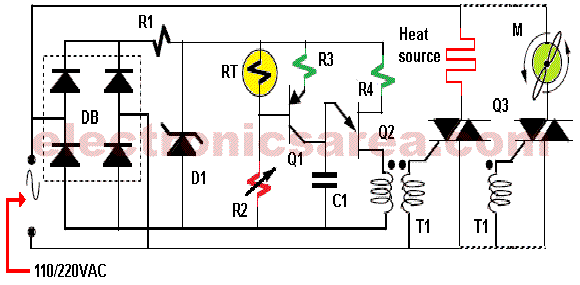Home / Circuits / Controllers /
Heat control using thermistor and TRIAC
This heat control using thermistor and TRIAC circuit, is designed to control the temperature of a room, either by using a heat source such as an electric oven heating element or by using a fan or any cooling device.
The trigger circuit is achieved using an Unijuntion Transistor (UJT) that introduces a conduction angle on the TRIAC. This conduction angle depends on the temperature of the room measured through a thermal resistance or thermistor (RT). This thermal resistor or thermistor has a value of 2 kilohms @ 25 °C.
The circuit is powered by a bridge diode rectifier and a zener diode that maintains the voltage stable for the trigger circuit.
Resistor R2 is set so that the PNP bipolar transistor Q1 is not in the cut-off state at a given temperature. When this transistor is in the cut-off state, no current will charge the capacitor C1, and therefore the UJT and the TRIACs will be in the cut-off state.
If this transistor is saturated (ON), it will charge the capacitor C1 and trigger the UJT when it reaches the Vp voltage. The time it takes to reach the VP voltage of the UJT depends on RT thermistor.
An increase in temperature, decreases the value of RT and consequently decreases the value of the collector current of the transistor by increasing the charge time of the capacitor (decreases the conduction angle). On the contrary, decreasing the temperature increases the driving angle.
To reverse the operation of this circuit and the way of operating with temperature, resistors RT and R2 are exchanged.
Heat control circuit component lists
- 1 Sprague Pulse Transformer (T1)
- 1 Rectification bridge MR1121 (DB)
- 1 Zener diode 1N5250A (20 volts) D1
- 1 bipolar PNP transistor 2N3905 (Q1)
- 1 UJT transistor 2N4870 (Q2)
- 1TRIAC MAC218A (Q3)
- 1 20k resistor, 1W (R1)
- 1 2K @ 25C thermistor (RT)
- 1 50K potentiometer (R2)
- 1 10K resistor (R3)
- 1 1K resistor (R4)
- 1 0.1 uF (microfarads) capacitor (C1)
The circuit can be powered with 220 or 110 VAC. It also depends on the supply voltage needed for the heat source and AC motor.
More Controller circuits
- Water Level Controller using Transistor and Relay
- Automatic Water Level Controler
- Water level controller using NOR gates
- Differential Temperature Controller (PCB)
- Soldering Iron Temperature Controller
- Heat control using thermistor and TRIAC
- Thermistor Controlled AC Fan
- Electronic Thermostat using transistors
- H-Bridge DC Motor Control
- DC motor speed controller using 555
- DC Motor Speed Control with 4049
- Dimmer / AC Motor Speed Controller using TRIAC





